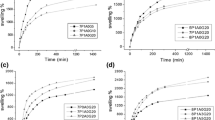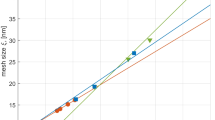Abstract
PVA chemical hydrogel can absorb a large amount of water to produce swelling, and the degree of swelling impact on its physical properties and applications significantly. Polymer and crosslinking agent concentration in the gelation stage can modulate degree of swelling and the structure of the hydrogel network. In order to further understand the modulation mechanism, it is necessary to develop method to establish model of hydrogel network and use it to calculate the degree of swelling. In this paper, a method for simulating PVA chemical hydrogel cross-linking reaction process and constructing a hydrogel network structure based on stochastic process is proposed. Using this method, the influences of amount of PVA and the amount of crosslinking agent on the network structure are obtained. The free energy and swelling degree of the hydrogel are calculated using the constructed hydrogel network. The quantitative relationship between the amount of PVA, crosslinking agent and the actual swelling degree of the hydrogel is obtained. The calculation results show that the increase of the PVA concentration and the decrease of the amount of the cross-linking agent can promote the swelling of the hydrogel. The calculated results of swelling degree are in good agreement with the experimental results. The method proposed in this paper can be used as an effective tool to study the network structure and mechanical properties of hydrogels.












Similar content being viewed by others
References
Silva P, Crozier S, Veidt M, Pearcy MJ (2005) An experimental and finite element poroelastic creep response analysis of an intervertebral hydrogel disc model in axial compression. J Mater Sci Mater Med 16(7):663–669
Liu M, Guo T (2001) Preparation and swelling properties of crosslinked sodium polyacrylate. J Appl Polym Sci 82(6):1515–1520
Chen F, Tillberg PW, Boyden ES (2015) Expansion microscopy. Science 347(6221):543–548
Yuk H, Lin S, Ma C, Takaffoli M, Fang NX, Zhao X (2017) Hydraulic hydrogel actuators and robots optically and sonically camouflaged in water. Nat Commun 8:14230
Jiong W, Qiongyu W, Hui-Hui D (2018) Stress-free bending of a neo-hookean plate induced by growth: exact solution and experiments. Int J Non-Linear Mech, S0020746218300374.
Stammen JA, Williams S, Ku DN, Guldberg RE (2001) Mechanical properties of a novel pva hydrogel in shear and unconfined compression. Biomaterials 22(8):799–806
An Y, Koyama T, Hanabusa K, Shirai H, IItoh T (1995) Preparation and properties of highly phosphorylated poly(vinyl alcohol) hydrogels chemically crosslinked by glutaraldehyde. Polymer 36(11):2297–2301.
Chen KC, Lin YF (1994) Immobilization of microorganisms with phosphorylated polyvinyl alcohol (pva) gel. Enzyme Microb Technol 16(1):79–83
Bo J (1992) Study on pva hydrogel crosslinked by epichlorohydrin. J Appl Polym Sci 46(5):783–786
Mancinelli K, Lisboa F, Soares JF, Zawadzki SF, Wypych F (2013) Poly(vinyl alcohol) nanocomposite films containing chemically exfoliated molybdenum disulfide. Mater Chem Phys 137(3):764–771.
Ratan A, Kunchakara S, Dutt M, Tripathi A, Singh V (2019) 100 MeV Silicon9+ swift heavy ion irradiation-Strategic defect annealing approach to enhance the electrical conductivity of few-layered MoS2 sheets-PVA nanocomposite film. Vacuum 169:108939
Jiang S, Liu S, Feng W (2011) Pva hydrogel properties for biomedical application. J Mech Behav Biomed Mater 4(7):1228–1233
Nakane K, Yamashita T, Iwakura K, Suzuki F (1999) Properties and structure of poly(vinyl alcohol)/silica composites. J Appl Polym Sci 74(1):133–138
Mori Y, Tokura H, Yoshikawa M (1997) Properties of hydrogels synthesized by freezing and thawing aqueous polyvinyl alcohol solutions and their applications. J Mater Sci 32(2):491–496
Boyce MC, Arruda EM (2000) Constitutive models of rubber elasticity: a review. Rubber Chem Technol 73(3):504–523
Hirokawa Y, Okamoto T, Kimishima K, Jinnai H, Koizumi S, Aizawa K et al (2008) Sponge-like heterogeneous gels: hierarchical structures in poly(\r, n\r, -isopropylacrylamide) chemical gels as observed by combined scattering and confocal microscopy method. Macromolecules 41(21):8210–8219
Kroll DM, Croll SG (2017) Heterogeneity in polymer networks formed by a single copolymerization reaction: I. gelation and pre-gel structure. Polymer 115:154–163
Flory PJ (1953) Principles of polymer chemistry. Cornell University Press
James HM, Guth E (1947) Theory of the increase in rigidity of rubber during cure. J Chem Phys 15(9):669–683
Ronca G, Allegra GJ (1975) Approach to rubber elasticity with internal constraints. J Chem Phys 63(11):4990–4997
Gao XS, Jiang K (2004) Survey on geometric constraint solving. J Comp Aided Des Comp Graphics 16(4):385–396
Collins GE (1975) Quantifier elimination for real closed fields by cylindrical algebraic decompostion. ACM SIGSAM Bull 10(1):10–12
Latham RS, Middleditch AE (1996) Connectivity analysis: a tool for processing geometric constraints. Computer Aided Design 28(11):917–928
Maxwell DS, Tirado-Rives J, Jorgensen WL (1996) Development and testing of the opls all-atom force field on conformational energetics and properties of organic liquids. J Am Chem Soc 118(45):11225–11236.
Sun H, Ren P, Fried JR (1998) The compass force field: parameterization and validation for phosphazenes. Comput Theor Polym Sci 8(1–2):229–246
Rigby D, Sun H, Eichinger BE (2015) Computer simulations of poly(ethylene oxide): force field, pvt diagram and cyclization behaviour. Polym Int 44(3):311–330
Polanowski P, Jeszka JK, Krysiak K, Matyjaszewski K (2015) Influence of intramolecular crosslinking on gelation in living copolymerization of monomer and divinyl cross-linker. monte carlo simulation studies. Polymer 79:171–178
Blinder SM, Nordman CE (1974) Collision theory of chemical reactions. J Chem Educ 51(12):3072–3086
Tobita H, Zhu S (1997) Statistical crosslinking of heterochains. Polymer 38(21):5431–5439
Junmin Gao (2016) Polyacrylates networks synthesized by endlinking via radical addition-coupling reaction. Doctoral dissertation.
Flory PJ, Rehner J (1943) Statistical mechanics of crosslinked polymer networks II. Swelling Journal of Chemical Physics 11(11):512–520
Ding Y, Sokolov AP (2004) Comment on the dynamic bead size and kuhn segment length in polymers: example of polystyrene. J Polymer Sci B (Polymer Physics) 42(18):3505–3511.
Aoqing T (1985) Statistical theory of polymer reactions. Science Press, China
Acknowledgements
The authors acknowledge the support from the National Natural Science Foundation of China (11772130). This work was supported by National Natural Science Foundation of China under Grant 11772130.
Author information
Authors and Affiliations
Corresponding author
Additional information
Publisher's Note
Springer Nature remains neutral with regard to jurisdictional claims in published maps and institutional affiliations.
Rights and permissions
About this article
Cite this article
Jiang, X., Li, C. & Han, Q. Modulation of swelling of PVA hydrogel by polymer and crosslinking agent concentration. Polym. Bull. 80, 1303–1320 (2023). https://doi.org/10.1007/s00289-022-04116-2
Received:
Revised:
Accepted:
Published:
Issue Date:
DOI: https://doi.org/10.1007/s00289-022-04116-2




